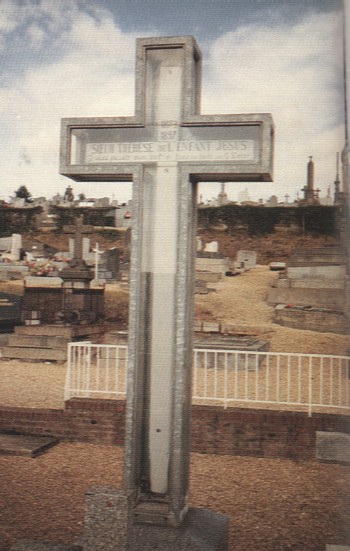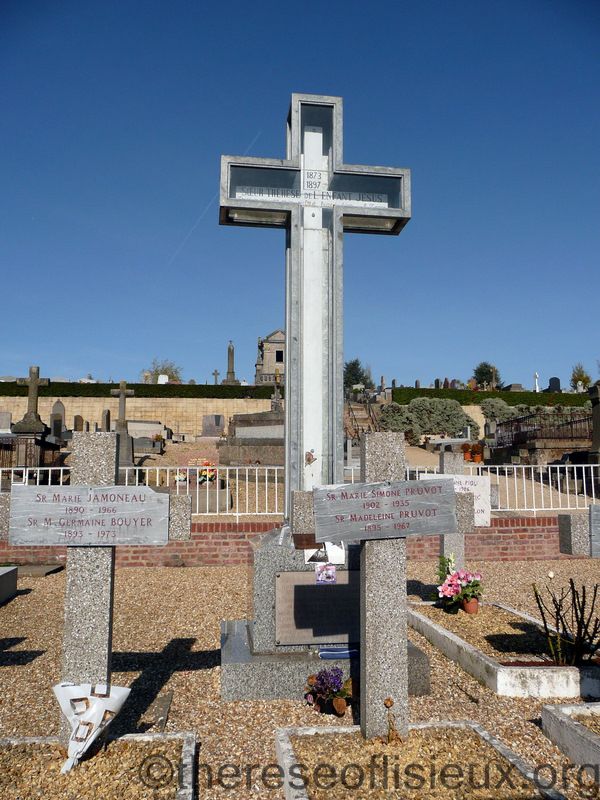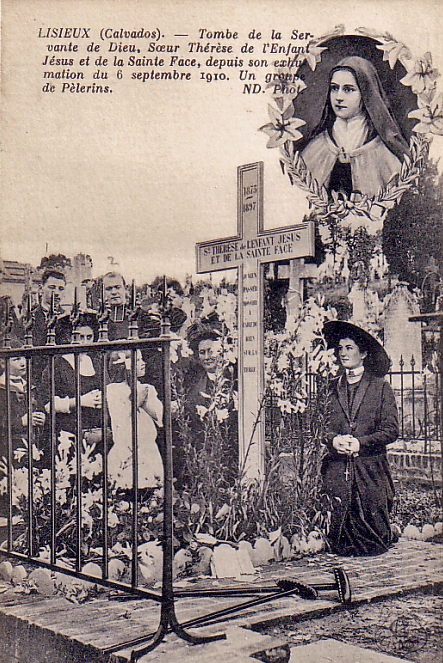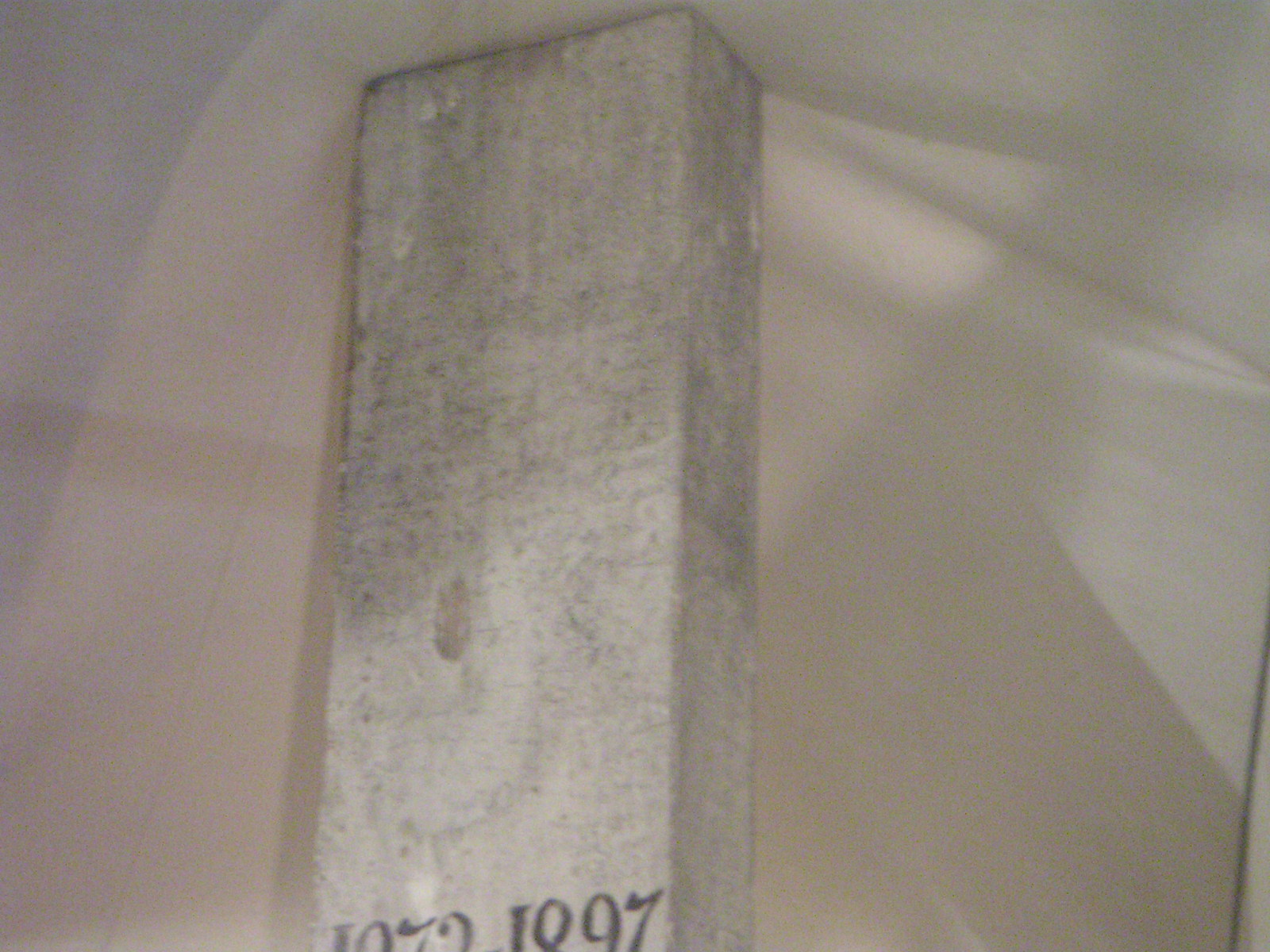In 1910, the diocesan Process for her beatification was introduced. According to the normal course of the process, it was interrupted on September 6, 1910 for the exhumation of her body, which had been deposited in the cemetery. Her remains--that is, all the bones, since nothing else remained other than some debris of flesh and clothing—were then placed in a new casket in order to ensure a better state of preservation, and were interred near her original grave.
During 1915, the Apostolic Process took place, followed by a further exhumation on August 9 and 10, 1917. An oak and lead coffin was put in the ground inside a simple brick vault. Then, at the mortuary chapel of the Lisieux cemetery, the true recognition of the remains took place. The bones were cleaned of the soil deposited on them between 1897 and 1910; they were carefully wrapped in fine linen to be transferred again into a small carved oak receptacle (1m 20X 0,40 X 0,30). This new receptacle was placed in a new sealed rosewood casket, and everything was reburied in the brick vault in the same cemetery. It was not until the Beatification was officially announced that the solemn and definitive translation of the body of Sister Thérèse to the Carmelite chapel took place on March 26, 1923.
Now nothing of St. Thérèse’s body remains in the Lisieux cemetery. The remains of her body, solemnly recognized according to a detailed and official verbal report, were destined to repose from then on in the Chapel of the Carmel of Lisieux, where changes had taken place to prepare for the Beatification, notably the construction of a small chapelbuilt on one side, named the “Chapelle de la Chasse” (the chapel of the tomb). This chapel contains a shrine containing a statue of St. Thérèse asleep in death. The statue is called the Holy Body. Inside this statue are sealed some of the bones of the saint. The remaining bones are underneath the statue, inside the tomb, to which workers have access from the rear when it is necessary to remove the relics. The bones are enclosed in the “Brazilian reliquary,” a small gilded reliquary offered by the faithful of Brazil.
Given the popular devotion to St. Thérèse and her relics, certain bones were donated in 1923 (to the Holy Father, to the Bishop of Bayeux), and a relic was saved for the basilica which was to be constructed. The cornerstone of the Basilica was laid in 1929; the Basilica was consecrated in 1954. The bones of St. Thérèse’s right forearm, which was considered the “human instrument” of Story of a Soul, are displayed and venerated in a suitable reliquary in the Basilica.
Another component of this story: a public exposition of the relics which takes place every year during the celebrations in late September leading up to the feast of St. Thérèse on October 1. The “Brazilian reliquary” is solemnly carried from the Carmel to the Basilica for a prayer vigil. The next day, the last Sunday of September, a Pontifical Mass is celebrated in the presence of the relics. During the afternoon, the small reliquary is carried from the Basilica to the Cathedral of St. Pierre in Lisieux; later it is returned to the Carmel. The relics themselves are not visible; only the reliquary can be seen.
St. Thérèse was proclaimed patroness of France in 1944. To celebrate this occasion, the reliquary was venerated by the faithful in Paris in 1945. In 1947 the relics traveled into many dioceses throughout France.
For the year 1997, the centenary of the death of St. Thérèse, there was a new demand that the reliquary might travel: Paris, Lyon, Marseille, cities that Thérèse herself had travelled through during her pilgrimage to Rome in 1887. These visits had a completely unexpected impact; the relics were sought out in many journeys crisscrossing France, Belgium . . .
Then there was an influx of requests from abroad. This was an opportunity to reflect on what had taken place, taking into account the inherent risks of such trips to the integrity of the relics: a whole year in Brazil; six months in Italy; four months in the United States; three months in the Philippines and Hong Kong, etc. It was no longer a question of sending all the relics. With the permission of the Vatican and under its supervision, only a portion of the relics were transferred to a reliquary of precious wood, an exact replica of the “Brazilian reliquary” with the same dimensions, but not gilded.
Of course, relics are constantly requested: for priests, churches, altars, the faithful, who want to possess a tiny fragment of bone (given more and more rarely because one cannot break the large bones); hair, clothing etc. . . . The demand is just about continuous from around the world. Relics, in a canonical sense, are the remains of the bodies of the saints. Souvenirs or other objects are not, strictly speaking, “relics.” One must also exclude all the published “writings.” The original manuscripts Thérèse wrote are scrupulously conserved in the Archives of the Lisieux Carmel; they never leave it.
FIRST EXHUMATION
On September 6, 1910 at the Cemetery of Lisieux
Extract:
Some of the graces and healings attributed to the intercession of the Servant of God Sister Thérèse of the Child Jesus, Shower of Roses, 1911
Appendix of the exhumations, pp. 103-109
Many times during her last illness, Sister Thérèse of the Child Jesus had announced that, according to her desire, after her death one would find only her bones.
“You have loved God so much, He will do wonders for you ; we will find your body incorrupt,” a novice told her shortly before her death. This idea seemed to pain her, and she answered somewhat sadly “Oh, no ; not that kind of wonder ! That would be a departure from my little way of humility ; little souls must find nothing to envy in me, so you can expect to find nothing but a skeleton. »[1]
The exhumation of the remains of the Servant of God, done in order to assure their preservation, not to expose them for veneration by the faithful, took place on September 6, 1910. We tried to keep the matter a secret, but it was nevertheless well enough known to allow a few hundred people to hasten to the cemetery.
Monseigneur Lemonnier, the Bishop of Bayeux and Lisieux; Monsignor de Teil, the vice-postulator of the Cause ; Canons Quirié and Dubosq, vicars general ; and many priests, including all the members of the Tribunal assigned to hear the beatification process, were present.
The work of exhumation presented many difficulties. The coffin had been buried at a depth of 3m. 50 and was in a very poor condition An expert in these kinds of maneuvers directed it. The coffin threatened to collapse, so, to create an artificial support to sustain it, he slid planks under the coffin. Then he wrapped it all in large canvases supported by strong straps. With much time and anxiety, we succeeded in pulling up the coffin without incident. As it appeared before his eyes, the Bishop, in a trembling voice, sang the song of David praising the Lord who will “draw the humble from the dust to seat them with the princes of his people.” And while the priests chanted the Laudate pueri Dominum, one noticed, through the disjointed planks, the palm leaf, all green and fresh as it was on October 4, 1897, the day it was first placed on the virginal body of the Servant of God.[2] Was this not the immortal symbol of the palm she had won by the martyrdom of her heart? This subject of martyrdom of which she wrote: “The palm of Agnes is needed for the lamb . . . and if this is not through blood, then it has to be through love. »[3]
We then opened the coffin. Two workers, father and son, who stood nearby, sensed in that moment a sweet and strong scent of violets that no natural cause could explain. They were deeply moved by this. One of these workers was the carpenter who made the coffins.[4]
The clothing appeared in order, it also seemed preserved, but this was only an appearance. The wimple and veils were gone; the large homespun scapular of the Carmelites had lost all consistency and tore easily without effort. Finally, as the humble child had wished, we found nothing of her but her bones!
One of the doctors present wanted to offer a parcel of the bones to Monseigneur Lemonnier, but His Grace opposed it and forbade that even the smallest portion be taken away. He accepted only the small boxwood cross that had been placed in the hands of the Servant of God.
The old coffin was then placed in a new coffin, which was placed in a lead coffin. Then the body was covered with a new habit that had been prepared for it, and the head covered with a veil crowned with roses, the last picked from the rose bushes of the Carmel which so often the angelic Thérèse had thrown at the feet of Calvary in the cloister garden.
At this time, by the order of Monseigneur Lemonnier, to please the silent crowd that had gathered and was standing in the cemetery, we removed the canvases that concealed the little Carmelite enclosure, and the coffin was placed on trestles in front of the gated door. For three quarters of an hour, the people never stopped processing in to pray, to touch pious objects to the body of Sister Thérèse. Monseigneur Lemonnier, the Bishop of Bayeux, was the first to touch the bones, with a piece of purple silk cloth he himself had brought for this purpose. Workers were seen bringing forth their wedding bands to touch them to the relics. All those who worked for the exhumation seemed imbued with respect. We estimate that about five hundred people venerated the remains after a three-hour wait.
An extraordinary supernatural expression, a feeling that they were not masters, invaded the assistants. The soul of Sister Thérèse, without a doubt, hovered near her mortal body, happy to offer to her Creator the annihilation of her physical being. One felt that something grand was happening, something solemn. Despite the dismal and humiliating realities of the tomb, the souls present, instead of being bewildered, troubled, or cooled in their faith and their love, on the contrary felt their veneration grow in fervor and in tenderness.
When the procession had ended, an official report written on parchment paper, stamped with the arms of Bishop Lemonnier, was enclosed in a metal tube and placed in the lead coffin. The coffin was then closed. On its cover is welded a plate with the inscription:
Sister Thérèse of the Child of Jesus and the Holy Face.
Marie-Francoise Thérèse Martin
1873-1897
The same text can be read on a copper plate attached to the oak coffin. Two fingerprints from each of the seals of Monseigneur Lemonnier and Monseigneur de Teil were affixed on the four corners of the welded sections of the lead coffin. It only remained to secure the oak cover. A few steps from the first grave, a new grave was dug, only two meters deep, where we had prepared a brick vault to the same dimensions of the coffin. Bishop Lemonnier, upon his arrival, had blessed the new grave. The precious remains were lowered.
In the evening, the planks removed from the coffin, some pieces of clothing, and the palm leaf, which the indiscreet devotion of the workers had torn into shreds, were brought back to the Carmel. The Sister charged with collecting these items smelled the scent of roses twice. The parcels of clothing and the casket gave out a scent of incense.
Another plank, detached from the top of the casket, which could not be found that same day, was found eight days later and brought to the monastery. The portress who had found it, doubting its authenticity a little, begged Sister Thérèse of the Child Jesus to manifest a visible sign. She was heard, for several sisters who had not been warned were embalmed with a marvelous scent of incense that came from that plank; one of them sensed it at a far distance.
But the tender heart of St. Thérèse still wanted to comfort those who love her by giving them a striking picture of the fullness of life she is enjoying in heaven. One of the souls she has favored in the circumstance of her celestial communications, and who is highly esteemed by pious and enlightened priests, testified under oath to the truth of the following narrative.
This person strongly desired to attend the exhumation and had planned on inquiring as to when it would take place. She believed it was not to be for some time yet. On the night after the exhumation, the night between September 6 and 7th 1910, she had a vision. In her vision, she saw a large crowd that she took at first to be a triumphal procession and a very solemn funeral. “Then,” she said, “I saw a young virgin radiating light. Her clothing of snow and gold sparkled everywhere. I could not distinguish her features, as they were imbued with light. From a reclining position, she raised herself up, seeming to come out of a shroud of light With a child’s candor and smile, she put her arms around me and gave me a kiss. At this heavenly touch I seemed to be in an ocean of purity, and I was drinking from the source of eternal joy. I do not have words to express the intensity of life that emanated from her whole being. Everything about her said without a word, by an inexpressible radiance of tenderness, how, in God, the home of infinite love, the blessed love in heaven.”
Unaware of what was happening in Lisieux, the happy privileged one asked herself who this young virgin was. Why did she appear to her out of a shroud while lying in bed? Three days later, reading in La Croixthe story of the exhumation, she was soon certain that it was Sister Thérèse who came to tell her of the event, and she went immediately to thank her at her tomb.
But it was not enough for the Servant of God to give to hers this proof of affection, to have told her as the angel said to Mary Magdalene; “Why do you look among the dead for one who is living? She still wanted to make promises for the future.
On September 5th, the eve of the exhumation, she appeared to the Reverend Mother Prioress of a Carmelite convent abroad, and, announcing to her that one would find nothing but her bones, “just bones,” she had foretold the wonders that would happen next. The Reverend Mother summarizes it like this: “These blessed bones will make stunning miracles and will be powerful weapons against evil.”
A few weeks later, the result of the exhumation came to the awareness of a professor at the University of X, a man of great intellectual achievement, of an eminent piety and, moreover, very favored by the Servant of God through all kinds of graces during the more than ten years he had known her. First of all, he was saddened that the body of the angelic virgin had decomposed like everyone else’s. As he gave in to his melancholy thoughts, he heard an interior voice answer him: “It was the dress of my day’s work that I threw off. I await the robe of the eternal Sunday ; I do not care what happens to the other.”
“And so,” he said, “I had a light that consoled me, I understood that this dissolution will spread atoms of her body everywhere, in such a way that not only her soul but also something of her body could be present and do good on earth.
It seems to me, indeed, all that really belonged to the body of a saint is a relic. If this is so, not only her bones but also the invisible molecules of matter can carry in them the grace of relics.”Is it not the answer to this desire so poetically expressed :
Lord, on your altars more than one new rose
Likes to shine.
It gives itself to you ….. but I dream of something else
To be unpetalled !... »[5]
August 9 and10th, 1917
The second exhumation and recognition of the remains of the Servant of God, Thérèse of the Child Jesus.
InRemembrance of the second exhumations and closure of the Apostolic Process of Sister Thérèse of the Child Jesus, in the Diocese of Bayeux, not paginated.
The first exhumation on September 6, 1910, was done under the sole inspiration of His Grace, Bishop Lemonnier, Bishop of Bayeux and Lisieux. It consisted solely of putting the unchanged remains back into a new coffin for better preservation. But before the closing of the Apostolic Process of the Cause of Sister Thérèse of the Child Jesus, in order to respond to the rules of the Church, we had to proceed to an anatomical recognition of the bones by doctors under oath.
For this purpose, Monseigneur the Bishop of Bayeux, accompanied by Monsignor de Teil, Vice-postulator, and members of the Ecclesiastical Court, dressed in choir habit, went to the cemetery in town in the afternoon of August 9, 1917.

































